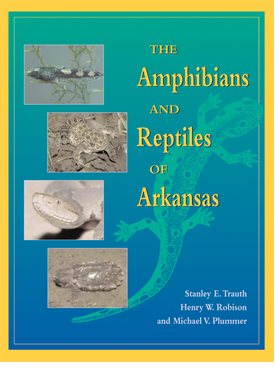The product of fifteen years of work by top herpetologists, this book is a comprehensive examination of the amphibians and reptiles of Arkansas, featuring over 136 species and subspecies. With over five hundred four-color photos, line drawings, and over one hundred maps, this user-friendly book will become the definitive text on the subject.
Published with the support of the Arkansas Game and Fish Commission.
Stanley Trauth is professor of zoology and director of the Electron Microscope Facility at Arkansas State University. The author of over two hundred articles in scientific journals, he is the editor in chief of the Arkansas Academy of Science and past president of the Southeastern Division of the American Society of Icthyologists and Herpetologists.
Michael Plummer is a professor of biology at Harding University. He has published seventy-four articles and holds adjunct appointments at Louisiana State University at Shreveport, University of Memphis, Southeast Louisiana University, and Southwest Missouri State University. At Harding, Plummer has held positions as the Coons Endowed Chair of Biomedical Sciences (1990–1995) and as the chairman of the Department of Biology (1986–1991).
Henry W. Robison is the author of five books and 116 scientific publications and a professor of biology at Southern Arkansas University, where he has studied the bio-diversity of Arkansas for the past thirty years. During his field studies, Professor Robison has discovered fourteen species new to science and has had the honor of having five species named after him. He is a member of numerous scientific societies, has been named SAU Honor Professor, received the SAU Faculty Excellence Award for Research, been named Arkansas Wildlife Conservationist of the Year by the Arkansas Wildlife Federation, and received the Outstanding Biologist Award from the Arkansas Chapter of the American Fisheries Society. He is the co-author of Only in Arkansas: A Study of the Endemic Plants and Animals of the State and Fishes of Arkansas.
“Has raised the bar for other state amphibian and reptile books. . . . This is the new benchmark.”
—Herpetological Review
“Highly recommended.”
—Southeastern Naturalist
“First-rate. . . . More than 500 excellent color photographs vividly illustrate not only adults of all species, but in many cases, the eggs and larvae.”
—Choice Magazine
“An excellent example of what states can accomplish toward documenting their natural resources.”
—Library News for Zoos and Aquariums
“A most important benchmark. . . . One hopes that authors and publishers . . . will not attempt to copy the book, but instead will use it as a baseline example to stimulate their own creativity and writing style.”
—The Bulletin of the Chicago Herpetological Society
“This is a stunning and wonderful contribution to the natural history of Arkansas, crammed with information and spectacular photography. The authors bring together their extensive knowledge of different groups and meld them in a way that ensures that The Amphibians and Reptiles of Arkansas will be a lasting and frequently used compendium.”
—Joseph T. Collins, director of Center for North American Herpetology, Wildlife Author Laureate of Kansas
“This book is obviously a labor of love. . . . The authors have done an excellent job. The text is well written, and the photographs and illustrations are superb. The Amphibians and Reptiles of Arkansas is an essential addition to the library of any herpetologist, and will be accepted eagerly by the scientific community.”
—James Dixon, professor emeritus at Texas A & M University and author of Texas Snakes and Amphibians and Reptiles of Texas
“This is a major work. The authors have done a superb job of compiling the most definitive work on the herpetofauna of Arkansas to date. The photography and illustrations are well done and the text is replete with pertinent information. The extensive and well-written keys to larval amphibians are absent from most state herpetological works, and for this reason alone herpetologists and biologists will use this work as an important reference. The authors are to be commended for producing this exhaustive and much-needed work by synthesizing their collective expertise and experience into a single
volume.”
—Kelly Irwin, herpetologist, Arkansas Game and Fish Commission

